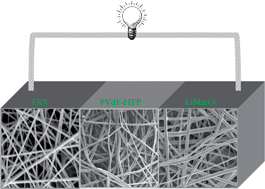A novel strategy to construct high performance lithium-ion cells using one dimensional electrospun nanofibers, electrodes and separators†
Abstract
We successfully demonstrated the performance of novel, one-dimensional electrospun nanofibers as cathode, anode and separator-cum-electrolyte in full-cell Li-ion configuration. The cathode, LiMn2O4 delivered excellent cycle life over 800 cycles at current density of 150 mA g−1 with capacity retention of ∼93% in half-cell assembly (Li/LiMn2O4). Under the same current rate, the anode, anatase phase TiO2, rendered ∼77% initial reversible capacity after 500 cycles in half-cell configuration (Li/TiO2). Gelled electrospun PVdF-HFP exhibits liquid-like conductivity of ∼3.2 mS cm−1 at ambient temperature conditions (30 °C). For the first time, a full-cell is fabricated with enitrely electrospun one-dimensional materials by adjusting the mass loading of cathode with respect to anode in the presence of gelled PVdF-HFP membrane as a separator-cum-electrolyte. Full-cell LiMn2O4|gelled PVdF-HFP|TiO2 delivered good capacity characteristics and excellent cyclability with an operating potential of ∼2.2 V at a current density of 150 mA g−1. Under harsh conditions (16 C rate), the full-cell showed a very stable capacity behavior with good calendar life. This clearly showed that electrospinning is an efficient technique for producing high performance electro-active materials to fabricate a high performance Li-ion assembly for commercialization without compromising the eco-friendliness and raw material cost.


 Please wait while we load your content...
Please wait while we load your content...